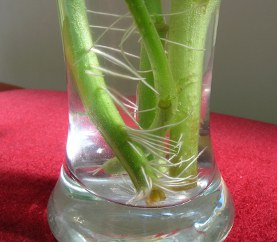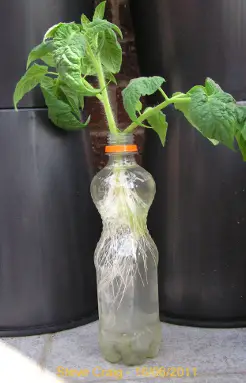We’re now about halfway through the season and plants should be flowering and setting fruit.
Tomato Cuttings
This week I’ve removed some rather long side shoots which I’ve decided to use as cuttings and create a few more plants – as if I had room for more!
All you need to do is to stand the cutting/side shoot in a glass of water and a week or two later, you will see roots growing out of the stem (see below).
When a seed is sown, you will notice the first root it makes is called a tap root. This is the root that goes down in search of water and the more fibrous roots remain closer to the soil surface – which is where most of the nutrients are.
Cuttings however, won’t have a tap root but just grow the finer roots. This means that a cutting will need to be watered more regularly especially in the early days. The quickest way to get water into a cutting is with a hand mist/sprayer.
When they are first transplanted into soil, it’s good to give them a regular misting with water.
Here are a couple of photos of cuttings and their developing roots.
 The photo above shows the result after nearly two weeks. Below is the result of root growth over a longer period (photo below by Steve Craig).
The photo above shows the result after nearly two weeks. Below is the result of root growth over a longer period (photo below by Steve Craig).
 These cuttings are well ready for planting!
These cuttings are well ready for planting!
Common Problems
At this time of the season, the most common problems are:
- Discoloured leaves
- Leaf roll or leaf curl
- Blossom drop
- Blossom End Rot
- Bugs, slugs and aphids.
Discoloured Leaves
Because nutrients are sent to the growing tip of tomato plants, lower leaves get ignored and go hungry. The result is nutrient deficiency showing itself in yellowing leaves etc.
Leaf Curl
Leaf curl on lower leaves is quite normal and nothing to worry about. However, curling leaves on the upper plant is usually due to stress – over watering or wide temperature fluctuations to name just two reasons.
Other reasons for leaf curl on new growth includes the curlytop virus but this is less likely than stress.
Blossom Drop
This happens when flowers fail to pollinate and the whole flower bud is aborted – you’re just left with the stem!
To avoid Blossom Drop, see “Good Vibrations“.
Blossom End Rot
This displays itself as brown leathery patches at the bottom of the fruit and renders the tomato useless. Most gardeners who have grown medium or large varieties have experienced this problem and I used to suffer from it too.
I once had a lovely yellow plum variety that had almost every tomato affected by BER – a very disappointing experience!
However, I now spray weekly with Chempak Calcium and BER is a thing of the past!
Bugs, Slugs and Aphids
Many of these problems can be controlled organically and by the use of friendly nematodes using Nemaslug or Nemasys – the most advanced way to control problems with little pests!
When To Stop Tall Varieties
It is standard practice to pinch out the growing tip of a tall variety in order to encourage tomatoes on a plant to grow and ripen more quickly.
I usually recommend four trusses for outdoor growing and around six trusses for greenhouse tomato plants.
If you live in a part of the world that has a longer growing season than the UK, you have time to grow more trusses and more time for the fruit to ripen.
I’m hoping to have a video on this page in a day or two so please check back – it’s been a very busy week and we’ve only just got the video camera working again!
Best wishes,
Nick


Emma
Hi Nick, thanks for this weeks newsletter.
A question about thick skins (tomatoes not mine!). I’m growing 4 varieties, 2 plants each; Sungold, Alicanti, Gardeners Delight and a bush plum Roma. All are beginning to ripen and I’m already picking Sungold. The taste is wonderful, sweet and juicy but they have very thick indigestible skins, which makes the eating less pleasurable. I guess there’s little I can do this year to cue it but what advice can you give for the future. We have chatted recently about my water and feeding regime which you approved…Thank You !!
Nick
Hi Emma,
Sungold does have a slightly thicker skin than some other varieties of the same size. That’s one of the problems with some cherry varieties – their skin is thick in proportion to their size and therefore more noticable.
Tomato skins, when they are growing, react to the weather conditions they have experienced. For example, wide temperature fluctuations and extremes of wet/dry soil conditions can have an effect on their skin thickness.
Tomato plants are clever and produce a thicker skin when growing conditions require it – especially when grown outdoors.
Tomatoes grown in a professional glasshouse will have had a very moderate life and no need to build up the defense of a thicker skin, so some supermarket toms may have a slightly thinner skin than an outdoor home-grown tomato, but the taste will be better in the home-grown tom.
Hope that makes sense …
Regards,
Nick
Bob Bruton
Nick
My tomatos are planted in pots outdoors and are now developing fruits. How often should I feed the plants?
PS all these plants grew after throwing compost on to a flower bed and appear to be very strong plants.
Nick
Ho Bob,
I feed my plants once a week from the time they begin to fruit. It also depends on which tomato food you are using as each brand has its own feeding instructions.
Regards,
Nick